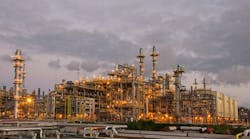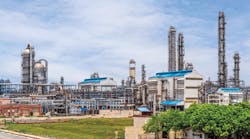Sam Fletcher
Senior Writer
Crude futures prices continued to test record highs in the wake of the symbolic attempt by the Organization of Petroleum Exporting Countries to deflate energy costs by raising its production quota to match existing output.
The July contract for benchmark US light, sweet crudes expired at $58.90/bbl, having gained $3.90 in its last week of trading on the New York Mercantile Exchange. The new near-month August contract closed at a record high of $59.42/bbl on June 23, up by $1.33 for the day after briefly touching $60/bbl as technical trading triggered preset orders during the session. Other monthly contracts also were up, with those through next June settling above $60/bbl.
"The broader scheme of things in the oil market is the testing of ever higher frontiers in order to find some level of comfort in market slack. With supply-side response being extremely limited, at least in the short-run, that testing has involved trying to achieve a sufficient drag on oil demand," said Paul Horsnell, Barclays Capital Inc., London.
"The oil market is being driven by products rather than crude," said analysts at the Centre for Global Energy Studies, London, in their June 20 monthly report. "Demand for middle distillates—jet fuel, diesel, and heating oil—is outstripping the ability of the refining system to produce it." They said, "Fears that refinery capacity constraints will prevent middle distillate supply from keeping up with strong demand growth are fueling a counterseasonal rally in distillate prices."
In his June 22 report, Horsnell noted that US retail prices for diesel averaged $2.313/gal, a level "just 0.3¢ below the all-time peak set in April" representing "a rise of 15.3¢ over the past 3 weeks."
Natural gas fluctuates
The July natural gas contract price fell June 20-22 by a total of 24.8¢/MMbtu as a break in the summer heat prompted profit-taking on NYMEX before it rebounded June 23 by 3.1¢ to $7.43/MMbtu.
Earlier gains in that session were pared after the Energy Information Administration released its weekly report on US natural gas storage. EIA reported 75 bcf of natural gas injected into US underground storage during the week ended June 10, up from 73 bcf the previous week but down from 85 bcf during the same period in 2004. US gas storage totaled 2.03 tcf after EIA revised down its estimated storage by 7 bcf to 1.96 tcf at the end of previous week. That change was recorded in the producing region, where injection fell from 12 bcf to 5 bcf. Nonetheless, storage remained 198 bcf above 2004 levels and 271 bcf above the 5-year average (OGJ Online, June 23, 2005).
"Many traders got long [holding near-month contacts that obligated them to take delivery] in front of the EIA number, hoping for the worst, but it came in on the high end of expectations, and when Tropical Storm Arlene is factored in, [the EIA report] was bullish," said analysts June 24 at Enerfax Daily. The storm made landfall on the Gulf Coast June 11.
Meanwhile, temperatures throughout much of the US were again higher than normal during the week ended June 18, with the Northeast continuing to see well above normal conditions. US summer weather was 16% warmer than normal yet 3% cooler than during the same period in 2004. "Season-to-date, national cooling degree-day temperatures are averaging 12% warmer than normal but 14% cooler than at the same period in 2004," said Ronald J. Barone, UBS Securities LLC, New York, in a June 23 report.
After normal to below-normal conditions in most regions of the country earlier that week, temperatures were expected to begin climbing. The National Weather Service called for above-normal temperatures in the central US, as well as the key gas-consuming regions of the Northeast and Midwest, while temperatures were forecast to be below normal along the West Coast stretching down to South Texas and in the Southeast.
"Assuming normal weather and the 9.17-bcfd 10-year average historical going forward injection rate, supplies would approximate 3.3 tcf by Nov. 1. We view these projections as relatively bearish for prices in the near-term given current surplus levels," said Barone.
Meanwhile, he said, market data "suggests that physical producers are more inclined to lock in production at current prices and speculators are increasingly bearish."
In his June 23 report, Barone said, "For the third straight week natural gas spot prices climbed higher to reflect the bullish energy complex, rise in futures, and continued warmer than normal weather in much of the nation (particularly in the Northeast)."
(Online June 27, 2005; author's e-mail: [email protected])

